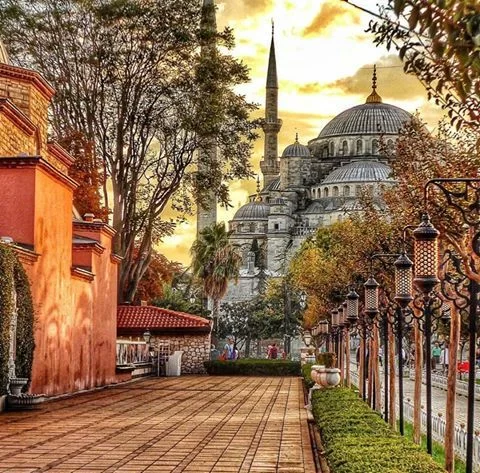Discover the Best Time to Visit Turkiye
Turkiye is a unique blend of history, culture, and natural beauty that captivates the hearts of travelers worldwide. With its four seasons, picturesque landscapes, ancient sites, and rich cultural heritage, visiting Turkiye is a must for any avid explorer. However, determining the best time to visit this gorgeous country can be a bit challenging, as it largely depends on your interests and priorities.
You might be wondering, when is the best time for a trip to Turkiye? The short answer is, although there is different weather in each of the regions of Turkiye, spring is the best time to visit Turkiye, autumn is next, then summer, last of all, winter.
In this article, we will guide you through the different seasons, climates, and events to help you make the most of your trip to Turkiye.
Four Seasons in Turkey: What to Expect
Turkey is known for its diverse weather conditions, with average temperatures varying significantly across the country. The Mediterranean coast, which includes popular tourist destinations like Antalya and Fethiye, experiences hot summers and mild winters.
Western Turkey, on the other hand, experiences fairly cold months from November to March, with low temperatures sometimes dropping as low as 5°C (41°F) in coastal regions like Izmir.
Weather and Climatic Regions in Turkey
Below is an overview of the four seasons and how they affect travel:

Spring (March through mid-June) is prime because the weather is moderate throughout the country and the days are long. April can be rainy. This is high season for Istanbul and Cappadocia, with many boutique hotels fully booked, and prices at their highest. However, it's the off-season for hotels and resorts. It's also a great time to visit the Southeast as the weather is mild.

Summer (mid-June through mid-September) is in five of Turkiye seven distinct climatic regions, though usually rainless, and cool inland in the evenings. Seaside resorts are crowded and prices are at their peak, but the cities are less crowded—Istanbul is a bargain, with smaller crowds and shorter lines for admission to sights. Cappadocia is cheaper and more comfortable as well.

Autumn (mid-September through October) is second best with mostly mild weather, but the days are shorter, and rain may begin again in October. This, too, is high season for Istanbul and, with many boutique hotels heavily booked at their highest prices. At beach resorts, the water is still warm, crowds are smaller, and prices are lower.

Winter (November, through February) can be chilly and rainy, with occasional cold but sunny days, everywhere except the southeast, which remains temperate, but lower prices and fewer tourists are compensations. I often travel to Turkiye in March and November to benefit from the lower prices, better availability of hotel rooms, and smaller crowds. However, beach resorts in the Mediterranean regions may be closed during the winter. Many tourist shops and restaurants in seaside towns will be closed during the off-season.
Tourist Seasons in Turkey
Peak Season: Summer Heat and Crowds
Summer is the peak season for visiting Turkey, with millions of tourists flocking to the country from June to August. The summer heat can be intense, with average temperatures reaching 30°C (86°F) in some regions. The Mediterranean coast is particularly popular during this time, thanks to its warm, clear waters and abundant sunshine. However, the summer months can also be extremely hot, especially in central and southeastern Turkiye, where high temperatures there can soar up to 40°C (104°F).
Although the summer heat can be overwhelming, it is an excellent time to visit Turkiye for cultural events, such many events such as the Istanbul International Music Festival and the Izmir International Fair. However, be prepared for large crowds, higher prices, and limited accommodation options during this peak season.
Shoulder Season: The Perfect Balance
The shoulder seasons – spring (April to May) and autumn (September to October) – are widely regarded as the best times to visit Turkiye . The weather begins to cool down during these months, making it ideal for exploring the country without the summer heat or the fairly cold months of winter. In addition, the crowds start to thin out, allowing you to enjoy tourist destinations at a more leisurely pace.
Spring is a fantastic time to witness and explore Turkiye's natural beauty, with lush green landscapes and vibrant flowers in full bloom. The fall foliage in western Turkey also adds a stunning backdrop to historical sites, such as the ancient city of Ephesus. Average temperatures during the shoulder season range between 15°C to 25°C (59°F to 77°F), offering a comfortable climate for sightseeing and outdoor activities.
Low Season: Embracing the Cold and Quiet
Turkiye’s low season, which spans from November to March, sees fewer tourists and lower prices for accommodations and attractions. Although the weather can be fairly cold during these months, especially in western Turkey and mountainous regions, it is still an excellent time to visit if you prefer to avoid crowds and are not averse to the chill.
The low season is also perfect for exploring Turkiye’s rich cultural heritage, as many museums and historical sites remain open year-round. In addition, winter sports enthusiasts can take advantage of the ski resorts in the country's mountainous regions, such as popular destinations like Uludag.
Summer in Antalya

Winter in Istanbul

Travel Advice: Making the Most of Your Trip
When planning your trip to Turkiye, keep in mind that the best time to visit depends on your personal preferences and priorities. The peak season offers a wealth of cultural events and beach-side fun but be prepared for the summer heat and crowds. The shoulder season is an excellent balance between pleasant weather and much fewer crowds of tourists, while the low season offers a more serene experience and lower prices.
Regardless of when you choose to visit Turkiye, there is no shortage of incredible sights and experiences awaiting you. Here are some additional travel advice and recommendations to help you make the most of your trip:
Dress appropriately: Depending on the season and region you visit, it is essential to pack suitable clothing. In the summer months, lightweight and breathable clothing is recommended, while layers and warm clothes are necessary for the fairly cold months. Additionally, keep in mind that conservative attire may be required when visiting religious sites.
Book accommodations in advance: Especially during the peak season, it is advisable to book your accommodations well ahead of your trip. This will not only secure your stay but also help you find better deals and options.
Consider guided tours: If you want to delve deeper into Turkiye’s history and culture, consider joining a guided tour. Expert guides can provide valuable insights and context to the various historical sites, making your experience all the more enriching.
Attend local cultural events: Turkiye is home to numerous festivals, concerts, and performances throughout the year. Be sure to check the local events calendar before your visit to experience the country's vibrant arts and culture scene.
Take advantage of public transportation: Turkiye’s well-connected public transportation system, including buses, trains, and ferries, makes it easy to explore the country without breaking the bank.
Other Things to Consider:
Airfares & Flight Times
When planning your trip to Turkey, it's essential to consider airfares and flight times. Airfares can fluctuate significantly depending on the season, with prices typically being higher during peak season and more affordable during low season. It's a good idea to start monitoring airfares several months in advance and set up price alerts to snag the best deals.
Flight times will also vary depending on your departure city and any layovers or connections. Non-stop flights from major European cities are usually between 3 to 4 hours, while flights from North America and Asia can range from 10 to 15 hours. Consider the total travel time and layovers when booking your flights to ensure a comfortable journey.
What to Wear & Pack
Turkiye has seven distinct weather and climate zones. You need to know a bit about them in order to pack the right clothes.
What you wear and pack depends on the season, itinerary, and which of these climatic regions you'll be traveling to. Here's a general guide to help you prepare:
Summer (June-August): Pack lightweight, breathable clothing, including shorts, t-shirts, and sundresses. Don't forget a hat, sunglasses, and sunscreen to protect yourself from the summer heat. A light jacket or shawl is recommended for cooler evenings or air-conditioned indoor spaces.
Spring (April-May) and Autumn (September-October): The shoulder seasons can see fluctuating temperatures, so it's wise to pack layers such as long-sleeve shirts, light sweaters, and jackets. A light rain jacket or umbrella is also useful for occasional showers.
Winter (November-March): Prepare for the fairly cold months with warm clothing like thermal base layers, sweaters, and a heavy coat. Waterproof boots, gloves, scarves, and hats are also essential for snowy or rainy conditions.
Regardless of the season, pack comfortable walking shoes for exploring Turkiye’s various historical sites and natural landscapes. Additionally, remember to bring modest clothing, such as long pants and tops that cover your shoulders, for visiting religious sites.
Festivals and Special Events

Turkiye boasts a rich cultural heritage and a lively arts scene, which is reflected in the wide array of festivals and events held throughout the year.
Here's an overview of some of the most popular Turkish festivals and events:
International Istanbul Film Festival (April)
The International Istanbul Film Festival is Turkiye's most prestigious film event, showcasing both local and international films across various genres. The festival aims to encourage the development of Turkish cinema while fostering cultural exchange through the medium of film. Visitors can attend screenings, panel discussions, and workshops with renowned filmmakers and actors.
Hidirellez (May)
Hidirellez is a traditional spring festival celebrated throughout Turkiye on May 5th and 6th. It marks the arrival of spring and the awakening of nature, symbolizing a time of renewal, hope, and prosperity. The celebrations include various rituals, such as cleaning homes, making wishes, and lighting bonfires. Music, dance, and feasting are also integral parts of the festivities.
Istanbul Music Festival (June)
The Istanbul Music Festival is a prominent event featuring classical music, opera, and ballet performances by both Turkish and international artists. The festival takes place at various historical and cultural venues throughout Istanbul, offering visitors a unique opportunity to experience world-class performances against a backdrop of the city's stunning architecture.
Kirkpinar Oil Wrestling Festival (June or July)
The Kirkpinar Oil Wrestling Festival is one of the oldest and most unique sporting events in Turkey, dating back to the Ottoman era. Held annually in Edirne, the festival sees wrestlers covered in olive oil competing in traditional bouts. The event is accompanied by music, food, and other festivities, making it a fascinating cultural experience for visitors.
Mevlana Whirling Dervishes Festival (December)
The Mevlana Whirling Dervishes Festival, held in Konya, commemorates the death anniversary of the renowned Sufi poet and philosopher Rumi. The festival features the mesmerizing Sema ceremony, a form of religious dance performed by the whirling dervishes, who seek spiritual connection with the divine through their movement.
Be prepared to book accommodations and transportation early or adjust your itinerary to avoid areas with large events.
Conclusion
The best time to visit Turkiye depends on your personal preferences and priorities. With its diverse climate, breathtaking landscapes, and rich cultural heritage, there is something for everyone in this gorgeous country.
Whether you choose to brave the summer heat, explore during the shoulder season, or embrace the fairly cold months, your trip to Turkiye is sure to be an unforgettable experience.








